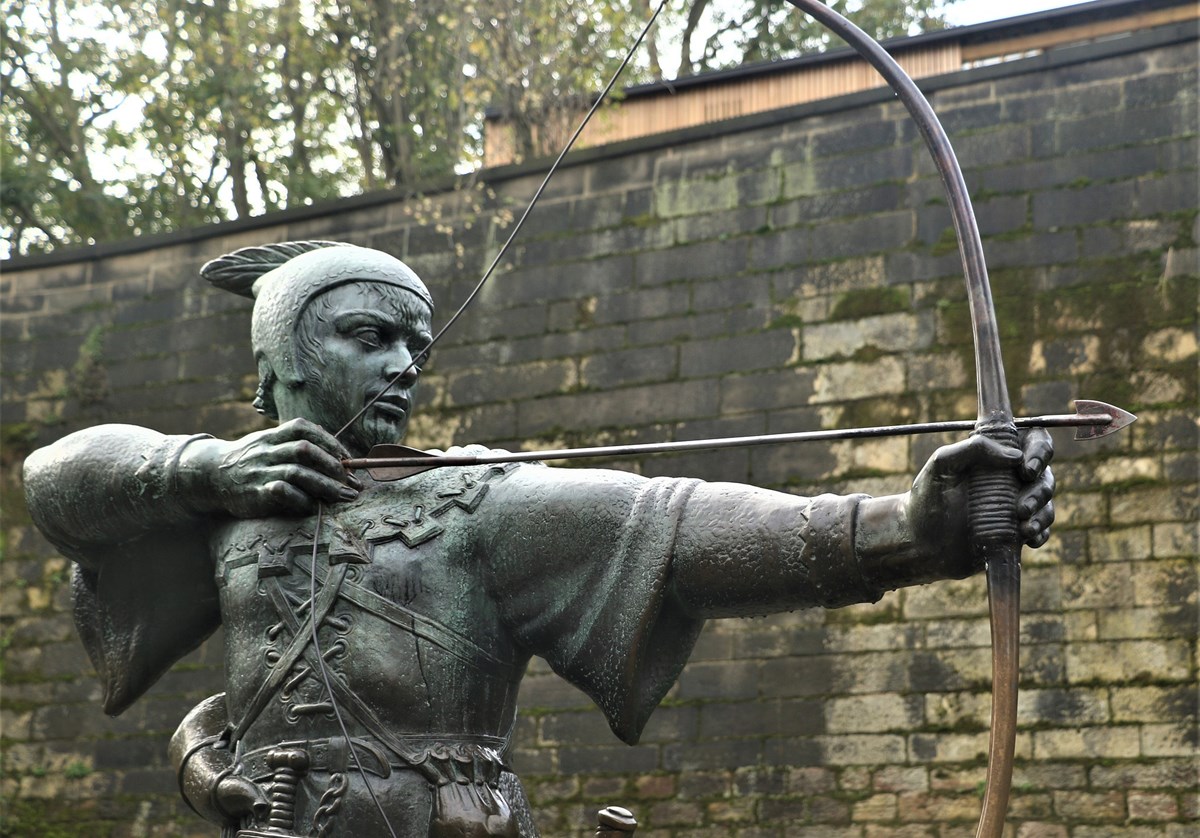Robin Hood may well be the most beloved rogue in all of literature. According to Wikipedia, he’s been the subject to date of at least 72 motion pictures and television productions, not to mention countless print versions of his story.
And why not? He’s got the most populist motto in the business.
“Take from the rich and give to the poor” was resonating with audiences for hundreds of years before the legend was actually set down on paper — and not just by Karl Marx.
John Chandler, author of “The Robin Hood Project,” (University of Rochester, 2006) dates the first mention of the outlaw in text back to 1377, but even that was just a reference to a character already widely known in the Sherwood of Barnsdale area. Some scholars have traced him back to a real person named Robert Hode who lived in the 1100s, but most believe that, beyond a superficial resemblance in spelling, it’s highly unlikely any real person’s exploits could rival the fictional version.
Interestingly, early descriptions of Robin Hood left out the “give to the poor” half of the equation, no doubt because, in those days, monarchs were sufficiently unpopular that just stealing from them was virtue enough.
Giving to the poor would have been icing on the cake.
Dr. Christopher Syn was the creation of novelist Russell Thorndike, who published his first volume in 1915.
As the years went by and one storyteller endeavored to outdo all the others, however, the tale was gradually embellished to the point where Robin began sharing his booty with the poor. Before long, he became the literary metaphor for income redistribution and the darling for centuries of those advocating for big government and the taxes needed to fund the welfare state they envisioned.
That problem with that calculation, of course, was that it ignored what drove Robin to a life of crime in the first place — namely high taxes and overregulation.
But even though much has changed since the days of Medieval England, the fundamental laws of economics haven’t. And while we no longer have kings and castles, it’s certainly no coincidence that, according to U.S. Census figures, eight of the ten wealthiest counties in the U.S. are within commuting distance of Washington, D.C.
And yet we still have poverty.
Then as now, there are rich people and there are poor people. But the real money is in making the rules that determine who gets to be which.
What we’ve discovered, much to our chagrin, is that the Robin Hood School of Economics — as wildly popular as it may be in books — doesn’t work in practice because simply giving people someone else’s stuff doesn’t reinforce the good habits one needs to earn enough money to buy their own stuff.
It took 400 or so years for that lesson to sink in, but by the time another great do-gooder of English literature arrived on the scene in the late 1700s, we’d learned a thing or two about capitalism.
Dr. Christopher Syn was the creation of novelist Russell Thorndike, who published his first volume in 1915. And like Robin Hood, while he might not have actually existed, he was invented out of genuine economic necessity.
The real-life inhabitants of the marshlands in southern England, like their descendants in Nottingham’s Sherwood Forest, were suffering under crippling taxes imposed by the British crown to pay for a series of wars waged in every corner of the globe to acquire and support its vaunted empire.
Thorndike, who grew up in the marshes of Southern England, was well-versed in the legend of gangs of roving outlaws whose only crime was a penchant for free enterprise.
Thorndike’s fictional Dr. Syn, vicar of the Kent village of Dymchurch, sought to ease his parishioners’ burdens. But rather than simply stealing what didn’t belong to him and handing it to people who hadn’t worked for it, Dr. Syn organized the men of the region into a gang of smugglers.
To protect his identity, he donned a mask that resembled a terrifying scarecrow and, together with his fellow outlaws, offloaded kegs of rum and other highly taxed goods from French and Dutch ships in the dead of night.
The merchandise was then sold at much cheaper rates because its sales price wasn’t inflated by heavy import duties. This benefited the sellers, who were granted access — albeit illicit — to an important foreign market that had been closed to them because of protectionist governmental policies.
But it was also a benefit to the buyers, who could purchase goods at a price determined by market forces rather than arbitrary regulation.
More broadly, it forced domestic British manufacturers to innovate and economize in order to keep prices low enough to compete with foreign suppliers. Meanwhile, it provided employment — again, however illegal — to dozens of smugglers who otherwise likely would be a drain on public resources.
It's clear both the crown and the local entrepreneurs would have been better off in the long run by a more hands-off approach from the government.
Allowed to flourish legally, this commerce might one day have resulted in the development of a thriving port industry along the underutilized southern British coast and the creation of new wealth — rather than watching the same dollars simply being spent by different people — would grow the economy of the entire nation.
In hindsight, it's clear both the crown and the local entrepreneurs would have been better off in the long run by a more hands-off approach from the government.
Thorndike, who grew up in the marshes of Southern England, was well-versed in the legend of gangs of roving outlaws whose only crime was a penchant for free enterprise.
And if their real-life leader wasn’t a swashbuckling cleric disguised as a living hobgoblin, he arguably had something better — a firm grasp of sound economics.

